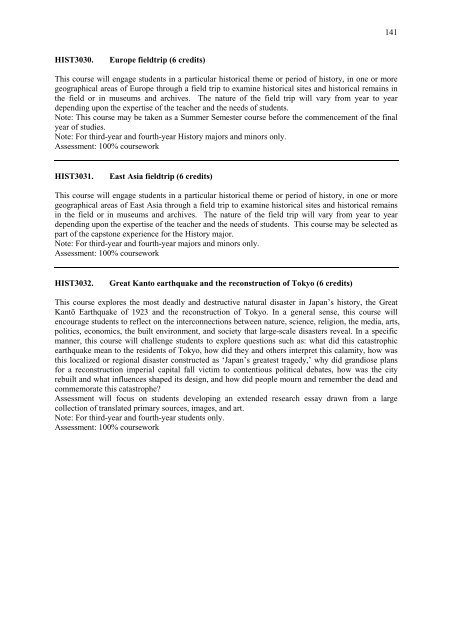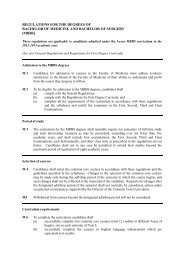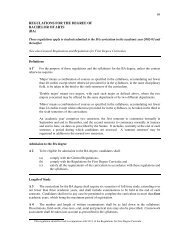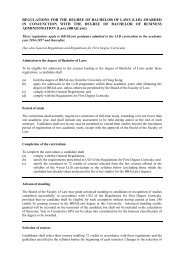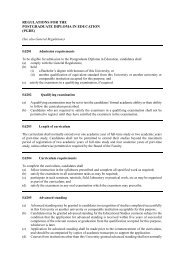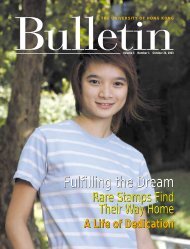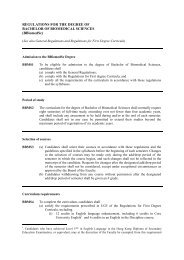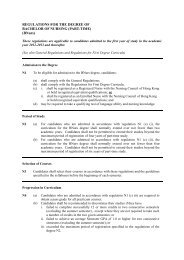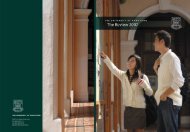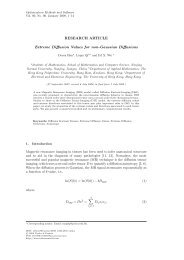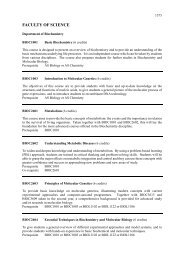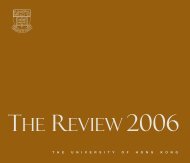- Page 1 and 2:
REGULATIONS AND SYLLABUSES(BA 4-YEA
- Page 3 and 4:
2Period of studyA 3 The curriculum
- Page 6 and 7:
5(c)(d)Honours classification may n
- Page 8 and 9:
7ENGLISH LANGUAGE ENHANCEMENTCAES10
- Page 10 and 11:
9MAJORS AND MINORS OFFERED BY THE F
- Page 12 and 13:
11CHIN1105.History of Chinese liter
- Page 14 and 15:
13CHIN2127.Classical Chinese fictio
- Page 16 and 17:
15CHIN2146.The “sickly beauties
- Page 18 and 19:
17Capstone experience coursesCHIN41
- Page 20 and 21:
19This is a two-week intensive cour
- Page 22 and 23:
21CHIN2243.History of Chinese scien
- Page 24 and 25:
23CHIN2268.History of China-West cu
- Page 26 and 27:
25Prerequisite courseStudents inten
- Page 28 and 29:
27CHIN2332.Translation in Hong Kong
- Page 30 and 31:
29CHIN3311.Translation and sinology
- Page 32 and 33:
31Advanced coursesCHIN9503.Chinese
- Page 34 and 35:
33SCHOOL OF ENGLISHINTRODUCTIONThe
- Page 36 and 37:
35List B: Critical Reading, Analysi
- Page 38 and 39:
37ENGL3034.ENGL3036.ENGL3037.ENGL30
- Page 40 and 41:
39discipline. It also traces the hi
- Page 42 and 43:
41ENGL1026.Adaptation: From text to
- Page 44 and 45:
43language) that normalize and natu
- Page 46 and 47:
45ENGL1042.World Englishes matters
- Page 48 and 49:
47ENGL2030.World Englishes (6 credi
- Page 50 and 51:
49ENGL2069.Form and meaning (6 cred
- Page 52 and 53:
51ENGL2093.Literary islands: Englis
- Page 54 and 55:
53ENGL2113.Conrad and others (6 cre
- Page 56 and 57:
55ENGL2125.English construction gra
- Page 58 and 59:
57ENGL2133. Topics in cross-cultura
- Page 60 and 61:
59LCOM2003.Language and politeness
- Page 62 and 63:
61ENGL3037.Research seminar in lang
- Page 64 and 65:
63Prospective minors are required t
- Page 66 and 67:
65ENGL2057.ENGL2069.ENGL2092.ENGL20
- Page 68 and 69:
67approaches to discourse and inter
- Page 70 and 71:
69ENGL1031.English grammar(s) (6 cr
- Page 72 and 73:
71ENGL1039.Realism and representati
- Page 74 and 75:
73ENGL2007.Literary linguistics (6
- Page 76 and 77:
75ENGL2099.Language, identity, and
- Page 78 and 79:
77and models of language, meaning a
- Page 80 and 81:
79LCOM2004. Language, communication
- Page 82 and 83:
81LCOM3005.Internship in language a
- Page 84 and 85:
83mbalax, high-life, bawa, morna, m
- Page 86 and 87:
85COMPARATIVE LITERATUREThe Departm
- Page 88 and 89:
87textual strategies. Students will
- Page 90 and 91:
89Brecht’s distancing effect and
- Page 92 and 93: 91CLIT2028.The city as cultural tex
- Page 94 and 95: 93CLIT2060.Fiction and film in cont
- Page 96 and 97: 954) Thoughts and emotions regardin
- Page 98 and 99: 97Note: This is a survey course whi
- Page 100 and 101: 99CLIT2093.20th Century fashion and
- Page 102 and 103: 101courses in the major, then, this
- Page 104 and 105: 103• Apply skills of critical int
- Page 106 and 107: 105FINE2027.The formation of modern
- Page 108 and 109: 107FINE2051.Art, politics, and soci
- Page 110 and 111: 109last fourteen centuries, includi
- Page 112 and 113: 111advances in military technology.
- Page 114 and 115: 113FINE3015.Arts of India (6 credit
- Page 116 and 117: 115HISTORYThe history programme at
- Page 118 and 119: 117comparative approach where possi
- Page 120 and 121: 119HIST2034.A history of education
- Page 122 and 123: 121residences; the defeat of the Pr
- Page 124 and 125: 123HIST2091.The British Empire (6 c
- Page 126 and 127: 125from the international community
- Page 128 and 129: 127HIST2113.New worlds: Exploring t
- Page 130 and 131: 129HIST2127.Qing China in the world
- Page 132 and 133: 131this evolution. Consequently, th
- Page 134 and 135: 133course will begin with two mid-t
- Page 136 and 137: 135transformational element. As our
- Page 138 and 139: 137HIST2134.The Third Reich through
- Page 140 and 141: 139HIST3017.Dissertation elective (
- Page 144 and 145: 143Students should enrol in the ‘
- Page 146 and 147: 145LING3111.Language and literacy i
- Page 148 and 149: 147LING3136.Child language (6 credi
- Page 150 and 151: 149LING3158.Topics in Cantonese lin
- Page 152 and 153: 151Other Computer Science Courses f
- Page 154 and 155: 153Capstone CoursesCapstone Experie
- Page 156 and 157: 155the basic critical tools to exam
- Page 158 and 159: 157course is offered in alternate y
- Page 160 and 161: 159created, performed, and consumed
- Page 162 and 163: 161MUSI3023.Composing for the conce
- Page 164 and 165: 163HKU Early Music Ensemble, HKU Pe
- Page 166 and 167: 165FIRST YEARThe department offers
- Page 168 and 169: 167PHIL2105.Vagueness, indeterminac
- Page 170 and 171: 169meanings of the words and senten
- Page 172 and 173: 171makes a word meaningful? What is
- Page 174 and 175: 173abounds at both levels, we will
- Page 176 and 177: 175Group IV: History of PhilosophyP
- Page 178 and 179: 177PHIL2050.Philosophy of history (
- Page 180 and 181: 179PHIL2470.Moral psychology in the
- Page 182 and 183: 181AMER2035. Addicted to war? The U
- Page 184 and 185: 183CORE COURSEAMER1050.Foundations
- Page 186 and 187: 185this course will take a closer l
- Page 188 and 189: 187AMER2038. American film, from Go
- Page 190 and 191: 189AMER2044.Wall Street: Issues in
- Page 192 and 193:
191later than November 30. The full
- Page 194 and 195:
193• Core courses (30 credits):EU
- Page 196 and 197:
195CAPSTONE EXPERIENCE COURSESEUST3
- Page 198 and 199:
197EUST3014.Love in the European tr
- Page 200 and 201:
199HIST2072.HIST2073.HIST2076.HIST2
- Page 202 and 203:
201Politics and Public Administrati
- Page 204 and 205:
203• Area Studies Courses (6 cred
- Page 206 and 207:
205CAPSTONE EXPERIENCE COURSEGCIN20
- Page 208 and 209:
207Category C: Industry and Busines
- Page 210 and 211:
209The MinorA minor in Hong Kong St
- Page 212 and 213:
211HKGS2004.Hong Kong’s economic
- Page 214 and 215:
213School of Modern Languages and C
- Page 216 and 217:
215• Interdisciplinary elective c
- Page 218 and 219:
217several weeks to the particular
- Page 220 and 221:
219JAPN2011.Anthropology of Japan (
- Page 222 and 223:
221JAPN2054.Strategy management: Fo
- Page 224 and 225:
223Co-requisite:Assessment:Either J
- Page 226 and 227:
225qualifications in the Japanese l
- Page 228 and 229:
227Follow the essentials of complex
- Page 230 and 231:
229CORE COURSESJAPN1011.Introductio
- Page 232 and 233:
231applicable teachers as to their
- Page 234 and 235:
233ELECTIVE COURSESJAPN1013.Situati
- Page 236 and 237:
235imperial court in the 11th centu
- Page 238 and 239:
237JAPN3017.Business Japanese (6 cr
- Page 240 and 241:
239JAPN2062. Japanese through Manga
- Page 242 and 243:
241List B. Inter-disciplinary non-L
- Page 244 and 245:
243Pre-requisites: NilAssessment: 1
- Page 246 and 247:
245Prerequisites:Assessment:KORE100
- Page 248 and 249:
247KORE3023.Korean writing 1 (6 cre
- Page 250 and 251:
249course includes lectures on vari
- Page 252 and 253:
251The MinorA minor in Modern China
- Page 254 and 255:
253MCSP2006.Modern China Studies di
- Page 256 and 257:
255CLIT2064.CLIT2065.CLIT2074.CLIT2
- Page 258 and 259:
257SOCI0052.SOCI0054.SOCI0066.SOCI0
- Page 260 and 261:
259ARAB2001.Arabic II.1 (6 credits)
- Page 262 and 263:
261- 30 credits from courses at Lev
- Page 264 and 265:
263FREN2002.French II.2 (6 credits)
- Page 266 and 267:
265FREN2029.French/Chinese - Words
- Page 268 and 269:
267Prerequisites:Assessment:Student
- Page 270 and 271:
269FREN3026.Conveying otherness: Fr
- Page 272 and 273:
271activities and, ii. samples of a
- Page 274 and 275:
273Assessment:School of Modern Lang
- Page 276 and 277:
275GRMN2023.Contemporary German soc
- Page 278 and 279:
277will design a personal portfolio
- Page 280 and 281:
279GREK1002.Greek I.2 (6 credits)Bu
- Page 282 and 283:
281ITALIANThe Italian programme is
- Page 284 and 285:
283structures and provides students
- Page 286 and 287:
285discussion of various aspects of
- Page 288 and 289:
287PORT2002.Portuguese II.2 (6 cred
- Page 290 and 291:
289- 30 credits from courses at lev
- Page 292 and 293:
291SPAN2002.Spanish II.2 (6 credits
- Page 294 and 295:
293and it is aimed at students with
- Page 296 and 297:
295SPAN2026.Spanish-writing worksho
- Page 298 and 299:
297Assessment:SPAN2002. Spanish II.
- Page 300 and 301:
299everyday situations such as shop
- Page 302 and 303:
301Prerequisite: Students must have
- Page 304 and 305:
303Assessment:Students wishing to b
- Page 306 and 307:
305CENTRE OF BUDDHIST STUDIESThe Ce
- Page 308 and 309:
307BSTC2008.Introductory Sanskrit (


